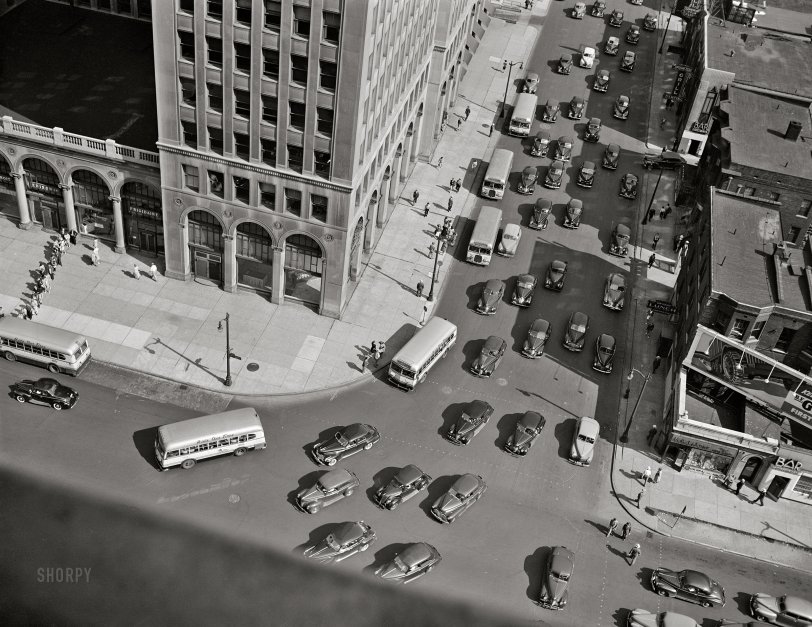


Framed or unframed, desk size to sofa size, printed by us in Arizona and Alabama since 2007. Explore now.
Shorpy is funded by you. Patreon contributors get an ad-free experience.
Learn more.

- Indiana Harbor Belt abides
- Freezing haze
- Corrections (for those who care)
- C&NW at Nelson
- Fallen Flags
- A dangerous job made worse
- Water Stop
- Passenger trains have right of way over freights?
- Coal
- Never ceases to amaze me.
- Still chuggin' (in model form)
- Great shot
- Westerly Breeze
- For the men, a trapeze
- Tickled
- Sense of loneliness ...
- 2 cents
- Charm City
- What an Outrage
- Brighton Park
- Catenary Supports
- Just a Little Before I was Born
- Afternoon normal
- The Flat Iron Cafe survives
- Aging in Place
- Raise your hand
- Good and Bad
- Oh, the 70's
- Nooooooi
- The aluminum tubing
Print Emporium
Second at Grand: 1942

July 1942. "Detroit, Michigan. View from Fisher Building of traffic at 5:30 on Second Avenue at Grand Boulevard." Acetate negative by Arthur Siegel, Office of War Information. View full size.
The Happy Couple
If you look closely, in the lower right corner, just to the left of the bar entrance, a young couple can be seen embracing, maybe kissing or even dancing, while an older man looks on. Betcha that was an interesting story.
Ah, young love.
Lots of Little Buses
The City of Detroit Department of Street Railways ran a huge fleet of small front and rear-engine Ford Transit buses during World War II. After the war the buses were worn out and replaced with a smaller fleet of larger buses. More details of DSR buses here. New streamlined PCC streetcars arrived in the late 1940s, but the final trips took place in 1956. Many were sold to Mexico City, where they ran for decades more.
Well-Ordered Line
Even more amazing than the spacing of the cars is the well-ordered line of people waiting to board the bus at the left. I wonder if they all were able to get on. If not, there were more buses waiting to turn the corner.
No lane stripes
I'm used to seeing stripes painted on the road. Or at least temporary markers before they're painted on. Is driving on an unstriped road another lost art?
Now, that's a queue!
Below is an aerial of the intersection of Second Avenue at Grand Boulevard today. Second went from a one-way street to a two. Since the building with the long and orderly line of people in front was General Motors headquarters, I'm guessing most of the vehicles we see are GM products. I hope so, because I am not seeing a lot of difference in the cars from this angle. I did notice running boards were disappearing.

Everybody form a line
The single-file (sidewalk-blocking) straight line running from the bus stop to the door of the General Motors Building is striking. The Arsenal of Democracy phase of Detroit's history was just getting started at the time of this picture. It would be interesting to see the congestion of bodies, buses and autos a year or two later.
Less Grand view
Here's a more mundane view of the same corner today. The building on the left is called Cadillac Place, and it's home to many State of Michigan offices. At the time of the photo, it was General Motors' headquarters.
The buildings on the right are long gone - they have been replaced by a small park. My wife remembers occasionally meeting GM folks at the bar on the corner after work - they claimed it was a convenient place to wait for traffic to clear.
Kinder, gentler rush hour?
Those rush-hour drivers of long ago were either remarkably well behaved or there were forces at work not visible in this fascinating photo. What seems to be missing here is a white-gloved traffic-directing cop out in the middle of a busy downtown intersection, or stoplights.
As late as the mid-1950's, in my much-smaller than Detroit hometown, traffic-directing cops still held forth during rush hours in the downtown business area's two busiest intersections. Their body English was impressive, as was their patience. Even so, they usually had a whistle in their mouth and could issue a loud, shrill reprimand to anyone who even started to make a move out of turn.
There's another interesting thing about this photo that might be lost on some viewers. Those city buses have signs on them, "Ride our tires." That was meaningful in a time when tires, like gasoline and batteries, were rationed because of the war.
La Dolce Vita
Judging by the age of the cars in this scene, life must have been good for Detroiters at that time. Very few of these vehicles are more than two models old. Surely that would not be likely in a comparable modern setting. But, then, who would be able to tell in any case?
Spacing
I’m struck by the non-bumper-to-bumper spacing between the cars. As well as the numerous diagonals in the arrangements of the cars, as though each driver looked hard left to see the front bumper of the car beside him.
So realistic
I wish I'd had a setup like that to play with when I was a kid.
























On Shorpy:
Today’s Top 5